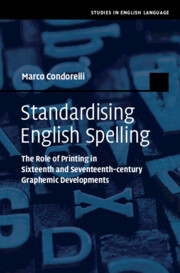 Standardising English Spelling
Standardising English Spelling Book contents
- Standardising English Spelling
- Studies in English Language
- Standardising English Spelling
- Copyright page
- Contents
- Figures
- Tables
- Acknowledgements
- Abbreviations
- Chapter 1 Introduction
- Part I Context
- Part II Empirical Method
- Part III Case Studies
- Chapter 7 The Standardisation of Positional Spellings
- Chapter 8 The Standardisation of i and y
- Chapter 9 The Standardisation of Etymological Spelling
- Chapter 10 The Standardisation of Vowel Diacritic Spelling
- Chapter 11 Conclusion
- Bibliography
- Index
Chapter 10 - The Standardisation of Vowel Diacritic Spelling
from Part III - Case Studies
Published online by Cambridge University Press: 31 March 2022
- Standardising English Spelling
- Studies in English Language
- Standardising English Spelling
- Copyright page
- Contents
- Figures
- Tables
- Acknowledgements
- Abbreviations
- Chapter 1 Introduction
- Part I Context
- Part II Empirical Method
- Part III Case Studies
- Chapter 7 The Standardisation of Positional Spellings
- Chapter 8 The Standardisation of i and y
- Chapter 9 The Standardisation of Etymological Spelling
- Chapter 10 The Standardisation of Vowel Diacritic Spelling
- Chapter 11 Conclusion
- Bibliography
- Index
Summary
Chapter 10 focuses on the standardisation of vowel diacritic spelling, and especially groups of graphemes indicating vowel quality and vowel quantity. Between the sixteenth and the seventeenth centuries, <ea˃ and <oa˃, indicating vowel quality, as well as <dg> and <g>, <tch> and <ch>, and <k> and <ck>, for vowel quantity, shifted from an early distribution principle to a new, modern standard. The results show a modern development that lasted throughout most of the sixteenth century, both in the two digraphs and in the consonantal alternants. By the seventeenth century, the uses of vowel diacritic spelling appear to have crystallised despite later ongoing vocalic developments in Early Modern English. The changes in the sets of graphemes investigated occurred uniformly across two generations, both at vocabulary level, encompassing high-frequency and low-frequency words concurrently, and also across most of the spelling units analysed. As for all the other case studies, my results indicate that there may have been a pragmatic agent behind the modern developments in vowel diacritic spelling.
- Type
- Chapter
- Information
- Standardising English SpellingThe Role of Printing in Sixteenth and Seventeenth-century Graphemic Developments, pp. 192 - 213Publisher: Cambridge University PressPrint publication year: 2022


